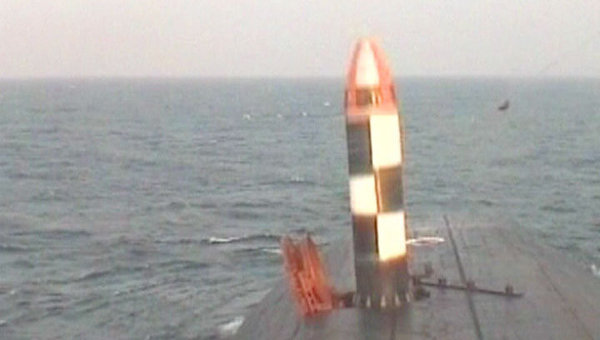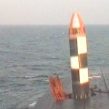
Bulava: Russia’s Most Spectacular Defense Industry Failure
Publication: Eurasia Daily Monitor Volume: 10 Issue: 188
By:

Moscow has long promoted its conventional defense modernization to 2020 as a means to strengthen the state’s claims to great power status. However, the Russian political and security elite continue to place considerably more emphasis upon the modernization of the nuclear deterrent; and in turn this has led to an exposure of unimaginable proportions of incompetence, poor planning and defense industry atrophy that has become synonymous with one term: Bulava. The failures to successfully design, test and introduce the new solid-fuel Bulava sea-launched ballistic missile (SLBM) resulted in the return of all its systems to the manufacturer. The chaos at the heart of this process will have long-term strategic implications for a state struggling to retain global influence (https://www.arms-expo.ru/049055051051124049048055055.html; https://www.kommersant.ru/doc/2274784).
Following the latest failed Bulava launch on September 6, Moscow suspended sea trials of the Alexander Nevsky and the Vladimir Monomakh nuclear-powered submarines, designed to carry Bulava missiles, and the defense ministry advanced the idea of five additional test launches of the troubled SLBM. Commissioning these Borei submarines into the Russian Navy depends upon the ultimate success of the Bulava, for which they were designed. The Bulava has officially failed eight of its twenty test launches, though some analysts consider the failure rate may be higher than publicly admitted. Although these failures have been blamed by Moscow on “manufacturing faults,” the defense ministry insists that there is no alternative to introducing the Bulava (RIA Novosti, September 7).
Head scratching over the ongoing Bulava saga in Moscow resulted in the formation of a commission to investigate its causes, headed by Russian Navy Commander in Chief Viktor Chirkov; the commission’s work was described as the largest of its kind in Russian history (Izvestiya, September 23). Reportedly, the commission formed several groups to inspect the Moscow Institute of Thermal Technology (MITT), which developed the Bulava, the Votkinsk factory, which built it, and “several enterprises” that prepared the critical assemblies and components for the missile; though the number of companies involved suggests the timescale for a thorough investigation would be considerably longer than officials suggest. “If the commission detects technological violations in manufacturing or errors in the organization plan, the Bulava missiles will be returned to the factory for diagnostics, and the acceptance of other items from the factory,” a defense industry source told Izvestiya.
Nevertheless, it was precisely at this point that the mystery surrounding the beleaguered Bulava SLBM began to deepen. Chirkov told Kommersant that the commission had “discovered” the cause of the latest Bulava failure, which could be traced to the “incomplete dilation (opening) of the second nozzle head,” confirming a manufacturing defect. Kommersant also reported, however, that this same defect was known as early as in 2010. Indeed, the September 2013 failure appears to resemble very closely the earlier Bulava mishap in July 2010, which witnessed a flaw in the missile’s nozzle between the first and second stages. In this context, the commission was certainly scrutinizing Perma’s Iskra nauchno-provizvodstvennoye obyedineniye (Science Manufacturing Association), tasked with producing the nozzle for all three stages of the missile (https://vpk-news.ru/articles/17556).
By late September, the deputy chairman of the Military-Industrial Commission, Oleg Bochkarev, reported that “the entire group of Bulava missiles” would be returned to the factory after the September 6 “disaster.” The entire group of Bulava missiles, whose numbers remain a state secret, need to be re-inspected in order for specialists to determine the causes of the failures. Some reports indicated that this would result in future telemetric testing. The Votkinsk factory was tasked to carry out this inspection and Bochkarev said that if monitoring equipment permitted inspecting prepared missiles in their place of storage, then it would happen on site (Vzglad, September 26).
Although Defense Minister, Army-General Sergei Shoigu and Deputy Prime Minister Dmitry Rogozin publicly clashed over the Bulava issue, the commission was due to complete its investigation by October 1. Many specialists, however, believed it would take much longer (RIA Novosti, September 18; Rossiyskaya Gazeta, September 19). The first deputy general director of the Votkinsk factor, Sergey Proskurin, remained cool about the investigation, insisting that his company was “prepared for any commission. We have had inspections after other failed launches of the Bulava, but in no case was a fault of the Votkinsk factory discovered. We assemble the missiles according to the design-engineering documentation, and the level of quality is sufficiently high, and there is proof of this” (Vzglad, September 26).
In short, the Russian answer is that no one is to blame, apparently leaving the Kremlin with the explanation that the Bulava is simply supernaturally jinxed. Independent Moscow-based defense analyst Aleksandr Golts notes that more than 650 defense companies are involved in the overall manufacturing and design and eventual “success” of the Bulava project, and sees the recurring nightmare of repeated failures as a symptom of the weaknesses of the domestic defense industry. “Generally, the rearmament of the Russian Army is entering a new cycle. Without any kind of results,” Golts concludes (https://kommersant.ru/doc/2280505).
It seems that the situation is no better for the much vaunted Bulava; failure to launch has become a national embarrassment. Bulava production must reach an estimated 128 missiles and many more warheads, overcome system design issues, planning flaws, technical and defense industry weaknesses. It has thus become synonymous with failure and with all that is wrong in Russia’s defense industry. In this context, as steps are taken to correct these flaws and eventually introduce Borei-class submarines equipped with Bulava missiles as part of the nuclear triad, Western governments should remain highly skeptical about other claims from Moscow about progress toward advanced conventional forces or, yet more farcical still, the long promise of “cyber-warfare command, which, like the Bulava, remains good on paper but not as a working instrument. More mysterious still, in this context, is the fact that Shoigu and Rogozin remain in their posts.




